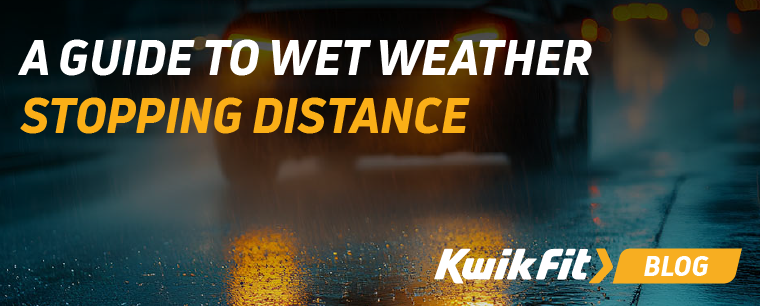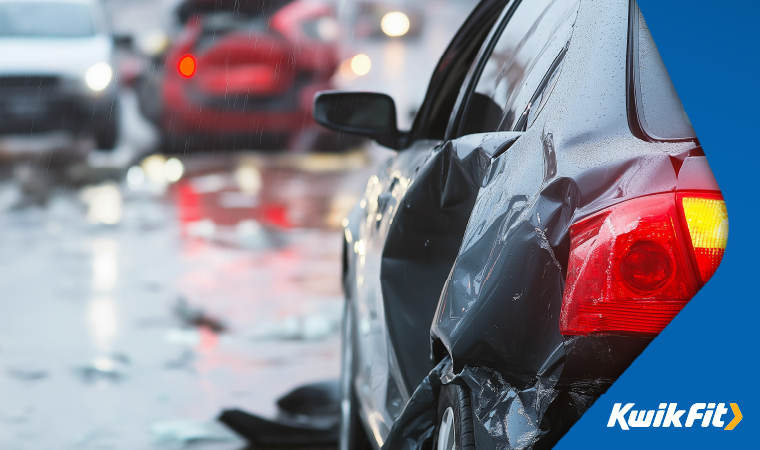A Guide for Winter Tyres & Stopping Distances
Kwik Fit | Monday 13th January 2025 9:00am

When it comes to driving, many British motorists aren’t aware of the requirements for winter tyres. Typically, most UK drivers don’t even know what winter tyres are, let alone why they’re a crucial part of vehicle maintenance and safety.
Winter tyres are for driving in cold weather conditions, including wet roads, not just snowy weather. These conditions bring with them a multitude of driving challenges we don’t experience in drier months, including an increase in stopping distances. Certainly not something you want to be caught off guard with.
But with the help of leading premium tyre manufacturer Continental, we’re determined to try and change UK motorists’ knowledge of this and help drivers become more aware of the important role that winter tyres can play in helping to prevent accidents on British roads. At the end of the day, when it comes to the right tyre selection, it’s all about stopping distance.
What is stopping distance and why is it so important?
First things first, what is a stopping distance? As a quick refresher, here’s a helpful formula:
Stopping distance = “thinking distance” (your reaction time) + “braking distance” (how far the car travels after the brakes have been applied until it stops).
In the warm, dry months of the year, stopping distance is already an important consideration, but when it comes to wet, cold months it’s even more significant. Did you know that your braking distances can double when driving in wet weather conditions? In hindsight, this may seem pretty obvious, since the road is much harder to grip when it’s covered in water.
For a visual demonstration of the difference a winter tyre can make to your vehicle's stopping distance, you can watch this video that Continental and Mercedes-Benz have made to educate drivers about wet and icy road conditions.
More on tyre types later, but let’s look at stopping distances in different conditions.
Stopping distances more than double in the wet
It’s crucial to understand stopping distances on the roads – especially motorways when driving at a higher speed and coming to a halt will take longer.
It takes 23 metres to react and brake in dry conditions at 30mph. At the average speed limit on a motorway of 70mph, it’d take 96 metres to stop in these conditions. With this in mind, to ensure safe braking distance in an emergency, you should be careful to leave enough room between you and the car in front when driving at high speeds.
According to the Highway Code, drivers should allow at least a two-second gap to the vehicle in front. This is often referred to as ‘the two-second rule’. As speeds increase, this gap should be wider, 2.4 seconds and 53 metres when driving at 50mph and 3.1 seconds or 96 metres when driving at 70mph.
However, if you’re driving in the rain, you need to leave twice the distance between you and the car in front in case you need to instantly stop at any speed. For example, if you’re driving at 70mph on the motorway, instead of 96 metres stopping distance, you’ll need 192 metres from start to finish. As the average British speed limit is 30mph, it will take 36 metres to stop in wet weather conditions.
Stopping distances can be 10 times longer in icy conditions
When you’re driving in snowy or icy conditions, the stopping distance compared to dry weather is an astounding 10 times longer.
We don’t ever recommend driving at 70mph when the weather is like this, but what this means is that if you were driving at 70mph, it would take a staggering 771m to stop.
Even at the speed of 20mph, it would take 120m to stop, so it’s important to be extra vigilant in snowy and icy conditions. Leave a distance between the cars in front and make sure you have the correct winter tyres in preparation for all weather conditions.
What are winter tyres?
Unsurprisingly, most people think that all tyres are the same. However, on closer inspection it’s clear that there are some key differences between winter and summer tyres. An important distinction is that the treads on winter tyres feature a noticeably different pattern, which offer more interlocking grip. Winter and summer tyres are also made from completely different rubber compounds.
How is this so? Winter tyres are much softer and, as a result, this allows them to grip cold roads better than summer tyres. Winter tyres really come into their own when the temperature is around 7°C or lower. At this point their special compound – optimised specifically to perform at their best in cold weather conditions – begins to pull its weight.
Find out about when to replace winter tyres, here.

Can't all-season tyres do the job?
This is a common question by motorists. Just like winter vs summer tyres, not every all-season tyre is the same. While they can be useful for city-drivers, cars with low mileage, or in mild winters, these conditions don't fit everyone's day-to-day motoring experience. If this form of driving doesn't fit you, all-season tyres aren't the right choice.
However, if this is your typical experience, an all-season tyre could be the right choice. So which should you go for? All-season tyres are – by definition – a compromise solution between the best qualities of summer (warm weather) and winter (cold weather) tyres. Finding the right balance is a real challenge for the tyre engineers and designers. Put simply, if you choose all-season tyres they need to perform:
- Better in warm weather than winter tyres.
- Better in cold weather than summer tyres.
- And well on rolling resistance, to help keep fuel bills down.
Ultimately, though, when it comes to the best performance and enhanced driver safety in cold and wet weather conditions, winter tyres will always be superior to all-season tyres.
Speak to Kwik Fit about the benefits of winter tyres
If you want to know more about how to improve your stopping distances in cold and wet weather conditions, or get tips on driver and tyre safety in general, contact your local Kwik Fit tyre experts.
With a network of over 600 centres across the UK, our expert technicians will be happy to provide you with experienced advice, including what’s best for your vehicle, as well as professional fitting solutions and more.
Any facts, figures and prices shown in our blog articles are correct at time of publication.
Featured Articles
Is it Illegal to Drive With One Headlight?
Saturday 19th July 2025
Wondering if it’s illegal to drive with one headlight? Learn about the safety risks and penalties of illegal blown bulbs and why you should fix them promptly.
Air Con in EVs & Hybrids: Experts Answer Your Questions
Monday 30th June 2025
Does air con drain EV batteries? Can you use the air con while charging an electric car? Find out the answers to these questions & more from Kwik Fit’s experts.
Why Is Your Car Making a Noise? Fixes & Tips
Friday 13th June 2025
When your car starts making unexpected noises, it can certainly be quite disconcerting; it may be nothing to worry about, but here’s what you need to know.









